Who Controls the User Experience? AMD’s Carrizo Thoroughly Tested
by Ian Cutress on February 4, 2016 8:00 AM ESTBenchmark Results: Web and Synthetic
Here are our results from our web and synthetic tests. A reminder of our systems:
| System Overview | |||||
| µArch | APU | Base / Turbo MHz |
Memory | Channel | |
| HP Elitebook 745 G2 | Kaveri | A10 PRO-7350B (19W) | 2100 / 3300 | 8 GB | Dual |
| HP Elitebook 745 G3 | Carrizo | PRO A12-8800B (15W) | 2100 / 3400 | 4 GB | Single |
| Toshiba Satellite E45DW-C4210 |
Carrizo | FX-8800P (15W) | 2100 / 3400 | 8 GB | Single |
| HP Pavilion 17z-g100 |
Carrizo | A10-8700P (15W) | 1800 / 3200 | 8 GB | Single |
| Lenovo Y700 | Carrizo | FX-8800P (15W) | 2100 / 3400 | 16 GB | Single |
Google Octane 2.0
Lots of factors go into web development, including the tools used and the browser those tools play in. One of the common and widely used benchmarks to judge performance is Google Octane, now in version 2.0. To quote: 'The updated Octane 2.0 benchmark includes four new tests to measure new aspects of JavaScript performance, including garbage collection / compiler latency and asm.js-style JavaScript performance.' We run the test six times and take an average of the scores.
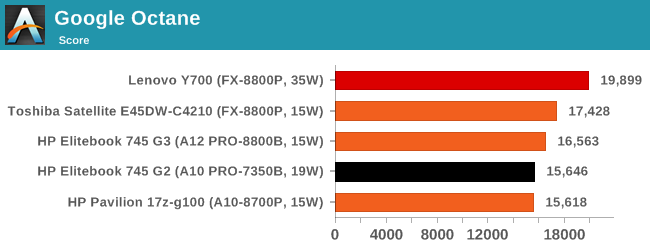
Octane splits hairs between the Kaveri and A10-8700P, but the Toshiba has the higher skin temperature and can turbo for longer than the Elitebook G3.
Mozilla Kraken 1.1
Kraken is a similar tool to Google, focusing on web tools and processing power. Kraken's tools include searching algorithms, audio processing, image filtering, flexible database parsing, and cryptographic routines.
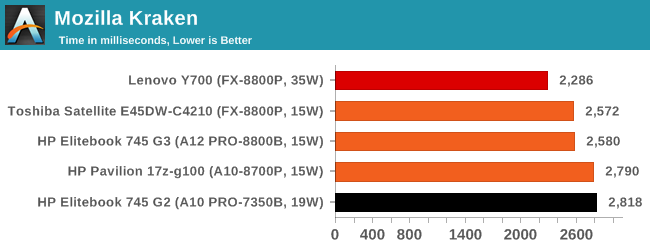
Kraken mirrors Octane, except this time the A10-8700P gets a jump on the Kaveri.
WebXPRT 2013/2015
WebXPRT aims to be a souped up version of Octane and Kraken, using these tools in real time to display data in photograph enhancement, sorting, stock options, local storage manipulation, graphical enterfaces and even filtering algorithms on scientific datasets. We run the 2013 and 2015 versions of the benchmark.
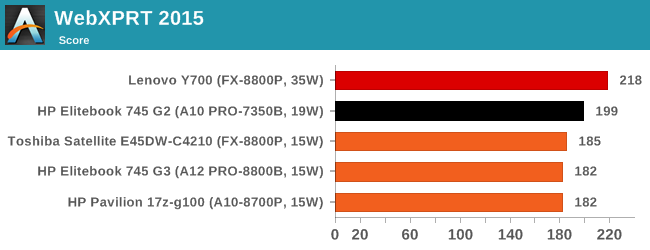
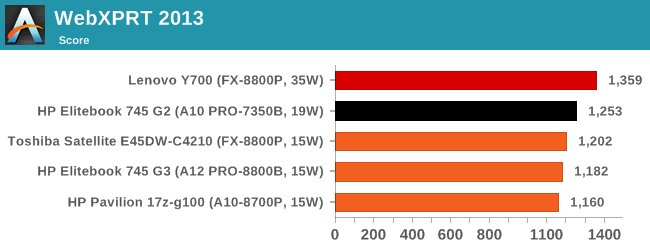
In both versions of the benchmark, the Kaveri system beats all the 15W Carrizo platforms. It was inevitable that at some point during the benchmarking that those extra four watts of thermal headroom in the chip might allow the CPU to turbo for longer – as WebXPRT is by nature a bursty workload, if it can use this to its advantage then we’ll surely see a regression.
I want to pull out some power numbers a little early here to show what I mean. Here are the two Elitebooks in WebXPRT 2013, whose scores differ by 6%:
These power numbers were taken under the ‘all else equal rule’, so each screen was at the same brightness and almost zero applications requesting run time in the background. Here we see that the Carrizo system is drawing less power on average in idle and load (a common theme), but suffers from higher peak power draw and a much larger average-to-idle change in power (which can be overshadowed by onboard components coming out of sleep). It means we get the very uneasy metric of 1208.7 J of energy consumed for the Kaveri over idle and 1932.8 J of energy consumed for Carrizo, though it does depend on how much idle is truly idle across the whole SoC and platform.
This might be where the performance deficit lies though – in a Carrizo system that boasts lower power at idle and lower power draw on average, in a bursty workload environment it is actually wasting time and power to switch things on and off constantly.
Cinebench 15/11.5
Cinebench is a widely known benchmarking tool for measuring performance relative to MAXON's animation software Cinema 4D. Cinebench has been optimized over a decade and focuses on purely CPU horsepower, meaning if there is a discrepancy in pure throughput characteristics, Cinebench is likely to show that discrepancy. Arguably other software doesn't make use of all the tools available, so the real world relevance might purely be academic, but given our large database of data for Cinebench it seems difficult to ignore a small five minute test. We run the modern version 15 in this test, as well as the older 11.5 due to our back data.
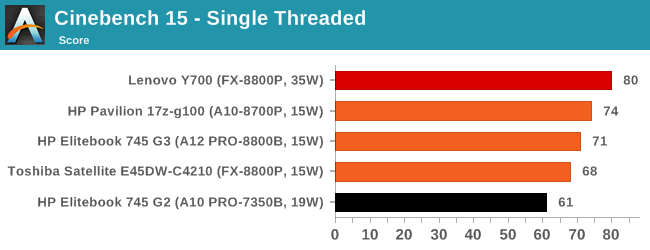

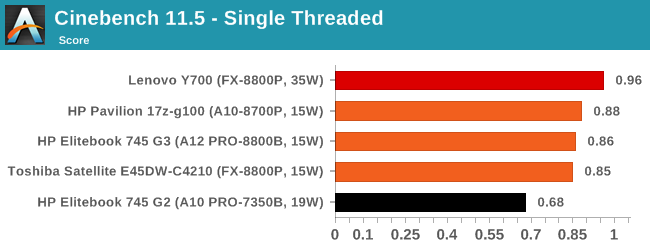
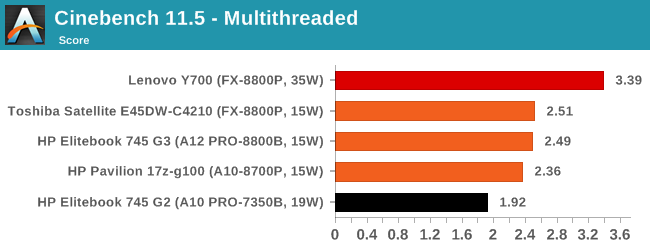
Cinebench shows the spread of performance relating to the microarchitecture advantages of Carrizo compared to Kaveri, as well as the benefits that a 35W part can give over a 15W part. That being said, this spread of results, while perhaps an academic answer to ‘which is the fastest’ is not often seen in the real world.
x264 HD 3.0
The x264 HD 3.0 package we use here is also kept for historic regressional data. The latest version is 5.0.1, and encodes a 1080p video clip into a high quality x264 file. Version 3.0 only performs the same test on a 720p file, and in most circumstances hits its limit on high end processors, but still works well for mainstream and low-end. Also, this version only takes a few minutes, whereas the latest can take over 90 minutes to run.
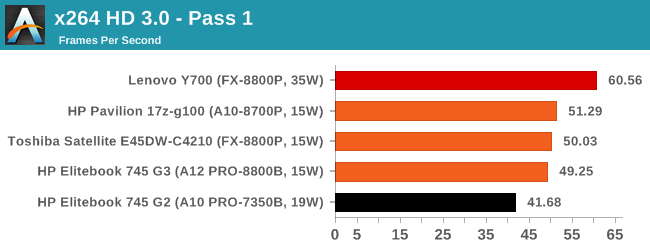
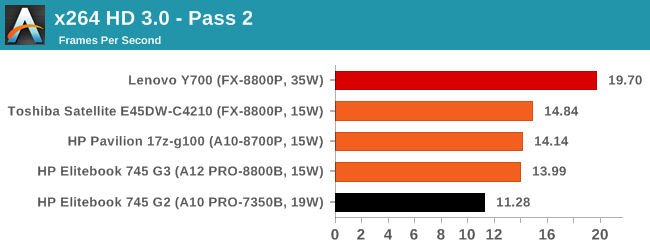
As with Cinebench, we get an ideal academic spread of data.






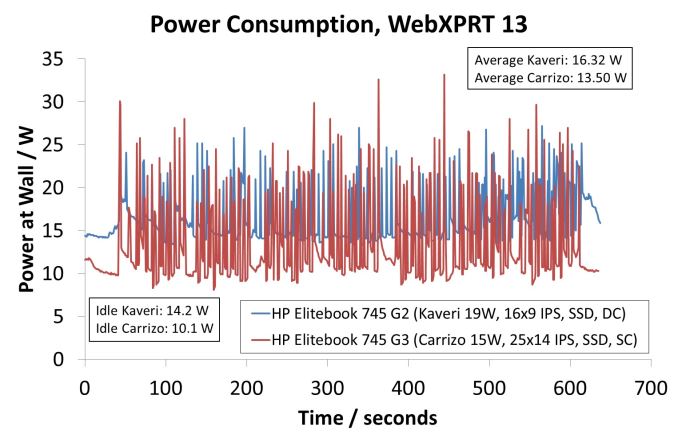








175 Comments
View All Comments
Kylinblue - Friday, February 5, 2016 - link
When I saw the sub-page title "AMD's Industry Problem" I though it is the conclusion, after reading that page I found out I am just at half of the whole article. Well done Ian, well done...ImSpartacus - Friday, February 5, 2016 - link
I know, right? I'm one of those weirdos that reads the pages backwards (mostly), so I was immediately surprised at the list of pages before the conclusion. I honestly haven't finished even half of the article, but it's already evident that some tlc went into it.just4U - Saturday, February 6, 2016 - link
A excellent article Ian.. and actually a surprise I wasn't expecting anything in the pipe like this right now.SviatAI - Friday, February 19, 2016 - link
Unfortunately, this often happens when you work for some ecommerce shop selling various goods, the boss of the shop may not want such kind of articles about the products he or she sells. They want it now and fast, just to fill the site with irrelevant content. The problem is that you want to make something better than a stupid re-write. But who cares? So, I am happy for those guys who write for AnandTech and other similar websites. They can learn something new while doing their job.CajunArson - Friday, February 5, 2016 - link
This article certainly proves one thing: When it comes to price lists on Intel Mobile parts, the numbers you see on ARK have absolutely nothing to do with the actual price that OEMs pay in real life.Observe the supposedly major $200 price premium for Intel chips when you read a price list in a vacuum, but then see that the real-life Intel system [with an honest-to-God *quad core* chip!] is basically selling for the exact same price as a much less capable Chorrizo part.
I personally got a Costco-Special notebook for the wife last year at $500.. it has an I5-5200U, and I assure you that the OEM most certainly didn't sell that notebook at that price after spending $300 on the CPU.
extide - Friday, February 5, 2016 - link
BTW, that's not a quad core. It's dual, with hyperthreading :)CajunArson - Friday, February 5, 2016 - link
When I said quad core I was referring to the Core i5-6300HQ (45W) in the price comparison that Anand posted. It is a 4 physical core part in a notebook that only costs $8 more than a "4 core" Carrizo using AMD's "cores".I am aware that the 5200U is a dual-core hyperthreaded part too. Like I said, the entire price of the notebook including the 5200U was only $500 (it has 8 GB of RAM too).
extide - Tuesday, March 22, 2016 - link
Ah, yes, Intel is FINALLY shipping quad core mobile i5's. Good call :)vladx - Saturday, February 6, 2016 - link
Except you didn't put in consideration that what you bought was called "Special" for a reason and it wasn't the release price of the product that was most likely $200+ more.Braincruser - Friday, February 5, 2016 - link
AMD still has a long way to go before its considered a valid choice. The 4.5W intel beats it in the tasks its gonna be used in. Even in graphics, the supposed strong side of amd's APU.